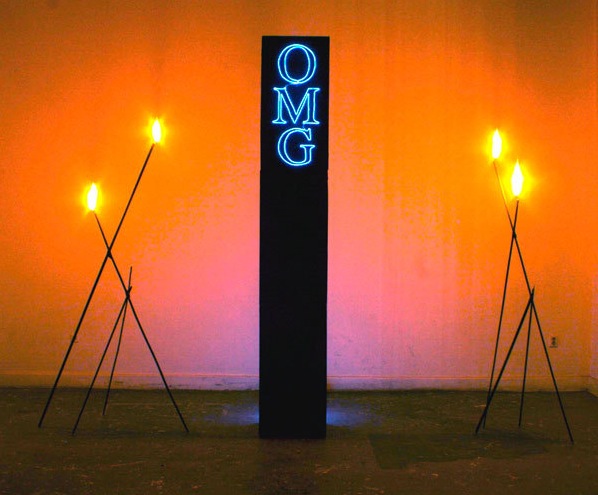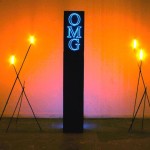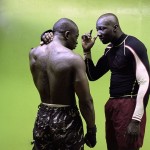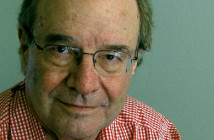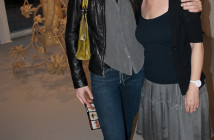YOUNGER THAN JESUS @ THE NEW MUSEUM
Much has been said and it would appear that even more has been written about the New Museum’s latest enterprise. The premier staging of this brand new triennial exhibition, carrying the burdensome lumber of a title that has by now been derided enough to here be met with compassionate omission, has received leagues of press from sources both credible (a recent mention here in BR&S) and otherwise in addition to the printing of two published catalogs weighing in at nearly one thousand pages total. It is with complete disregard to my better interests that I too shall attempt to leap into this textual fray.
The announced intent of this new endeavor is to present, on an international scale, the works of artists under the age of 33 in anticipation of emerging trends. As the self-anointed soothsayers of the coming forms of art, a group of some 150 persons led to the consideration of 500 young artists; fifty of whom were represented in the New Museum’s display. Not content to allow such an opportunity to devolve into a few young lads and lasses who happen to be known to a few curators and their extended network of friends; the works on view are promoted for their ability to define a generation that breaches the boundaries of culture, nation, and all other divisions of identity. These are the Millenials. This is Generation Y. As a young lad myself, I am allowed to say: this is me. Here I am. OMG.
As an artist and so-called Millenial it has proven all too easy to possess a jaded view of this effort. However, being a presently unknown and unsuccessful artist who has on numerous occasions chosen to sidestep from impoverished marginal city to impoverished marginal city I possessed no delusions about the possibility of my own inclusion in such an offering. That being said I trust that in stating my views I will be unclouded by any propensity toward contempt or covetousness.
As it would be in bad taste to attack these artists, many of whom have barely begun their careers and will likely alter their subjects and approach as time progresses, I will forego a critical discussion of any of the works on view. As has been reported elsewhere, some of the work was good, though much of it was not. Of course by saying a work is good in this context, I assume that the artist managed to create something that is timely, thoughtful, willing to mediate between an understanding of the past and the ability to act in the present and not to create something that is derivative or simply a mirror of their own puerility and youthful surroundings and accoutrements. However, with few exceptions, I was not interested in the work in the show, but rather the idea that an established institution like the New Museum might take it upon itself to become both tastemaker and de facto career maker (it should be noted that only a slim portion of the artists included were widely held in high regard upon inclusion) for the coming generations of artists. In this respect, the show has warranted comparison to a PS1 exhibition of a similar though more parochial nature. The prediction of coming trends by an institution in possession of such clout as the New Museum is loaded beyond what the banality of casually critiquing individual artists and their works may be able to appropriately address anyhow.
In order to determine what is at stake, let us first consider what is being defined. The grand prognosticators here are seemingly innocuous in their assertions. After all, they are not the sort to implement the Toynbeean cyclical thinking that an outsider forecaster like the nearly septuagenarian artist Paul Laffoley might employ to label our current era as Bauhauroque and a part of a somewhat optimistic progression of forms. No, these are well grounded, business-minded realists seeking to envision the future from a pallette of soiled bed sheets and spent electronics. This is the innocent cataloging of a familiar new. This is a new for which there are many historic analogues and clear antecedents. One artist has observably followed the path of Christian Marclay, a living breathing sleeping woman calls to mind a Chris Burden piece or a Janine Antoni, many others seem to have taken after the group of Los Angelinos that were finely gathered together in the LA Museum of Contemporary Art’s 1992 exhibition Helter Skelter, and others still appear to be working in the vein of the eponymous protagonist of John Water’s 1998 film Pecker. Perhaps there has been a cyclic presaging of sorts. Perhaps it is similar to the claim of Des Hermies from Joris Karl Huysmans’ tale of historic synchronicities Là-Bas when he states: “The tail ends of all centuries are alike.” Perhaps this business realism has ushered in the reemergence of an artistic and literary realism and its various offshoots in a somewhat timely manner and the “vacillation and uncertainty” of the recent past has just managed to hang on a bit longer than the end of so recently a concluded century. Or perhaps we are witness to a new fleet of Octave Mirbeau-like figures sardonically employing the tropes of previous decades in a willfully perverse product. Or is it as Huysmans’ protagonist Durtal retorts to his friend Des Hermies’ aforementioned remark "[whereas the previous]ilk had a certain audacity, and perhaps a little knowledge…the mages of our time [are]inept fakes!" I fear my own youthful age has made me uncertain, unable to pass such possible judgments, especially in regard to such matters as history, its augurs, and its oracles.
As it would seem that there is little novel by way of aesthetic device or conceptual strategy in this new work, perhaps there is a content driven difference or variation of technical methodology. The prevalence of net references, from myspace videos to the towering letters OMG, have managed to steer away from the revolutionary pretentions of the so-called net art from the previous decade championed by that haggard old institution Rhizome. However such works will too quickly fade from notice except for the near certain chiding they will receive from future art students peaking at outdated Art Forums. So what is the kernel of newness that exists at the base of this mountain of effort? Should we, in a manner befitting Adorno or Broodthaers just dismiss or perhaps playfully mock the invasiveness of the culture industry and the redundancy and abecedarian quality of its products; or is there something more to be found here. I find it hard to leave it at such a hasty conclusion. No, I believe the newness of this generation, of which I am a part, would appear to be found in the very lack of apperception within these hallowed walls and the inability of these younger producers to locate meaningful ways to participate in broader culture through either action or internalization. These are not the finger-in-every-pie sort of cultural producers that one might have found in the early twentieth century up to the dissolution of the radicalism of the 60’s or 70’s. Nor are they the culturally and historically savvy commentators of post-modernism. Further, it does not fit with the 90’s-ish reemergence of experimental practices found in such new forms as bio art and the revival of Situationist inspired tactics found in many less commonly acknowledged art circles. Though I do not know what we have here, I do know that I do not want it as an embodiment of “this generation” and surely not my own person. Perhaps other young artists are inclined to feel the same. Perhaps the artists of “this generation” should take it upon themselves to produce parallel realities, nay parallel realisms, a rebours, against the simplistic doubting and undervaluation of potential and ambition that the parental figures responsible for this exhibit have cast upon their children.
Unlike the New Museum, I await retrospection so I may clearly analyze the present moment free from the anxiety of having to learn that my prognostications were merely acts of short-sightedness and having to find that what I might now seek to reward did nothing more than attract others toward a false and irrelevant teleology. I am inclined to believe that allowing one’s generation, however insensible it might be to be passionately linked to an age group, to be so conveniently packaged by those that have preceded it may be both a misrepresentation and, even worse, wholly disempowering in the decision of one’s own cultural moment. Perhaps this has all been a misallocation of credibility. If so, let us allow time to inform us whether it was artist or institution that erred. In the mean time, I hope to avoid the simultaneous celebration and definition, birth and death, of the present era as espoused by the New Museum’s newly founded stillborn program. In a time when museums are all too eager to artificially harvest new traditions I hope that this one may be short-lived; though I am open to arguments that might make me think otherwise.
- AIDS-3D, OMG Obelisk, MDF, electroluminescent wire, steel, hot glue, acrylic paint and fire, 2007.
- Mohammed Bourouissa, La fenêtre, Lamda print mounted on aluminum, 2005.
- Ryan Trecartin, composite image from Sibling Topics (Section A and Section B), single-channel video installation, 2009. (Sets and installation in collaboration with Lizzie Fitch).
"Younger Than Jesus" was on view until July 5th at The New Museum, located at 235 Bowery, in New York City, NY.
All images are courtesy of the artists and The New Museum.

